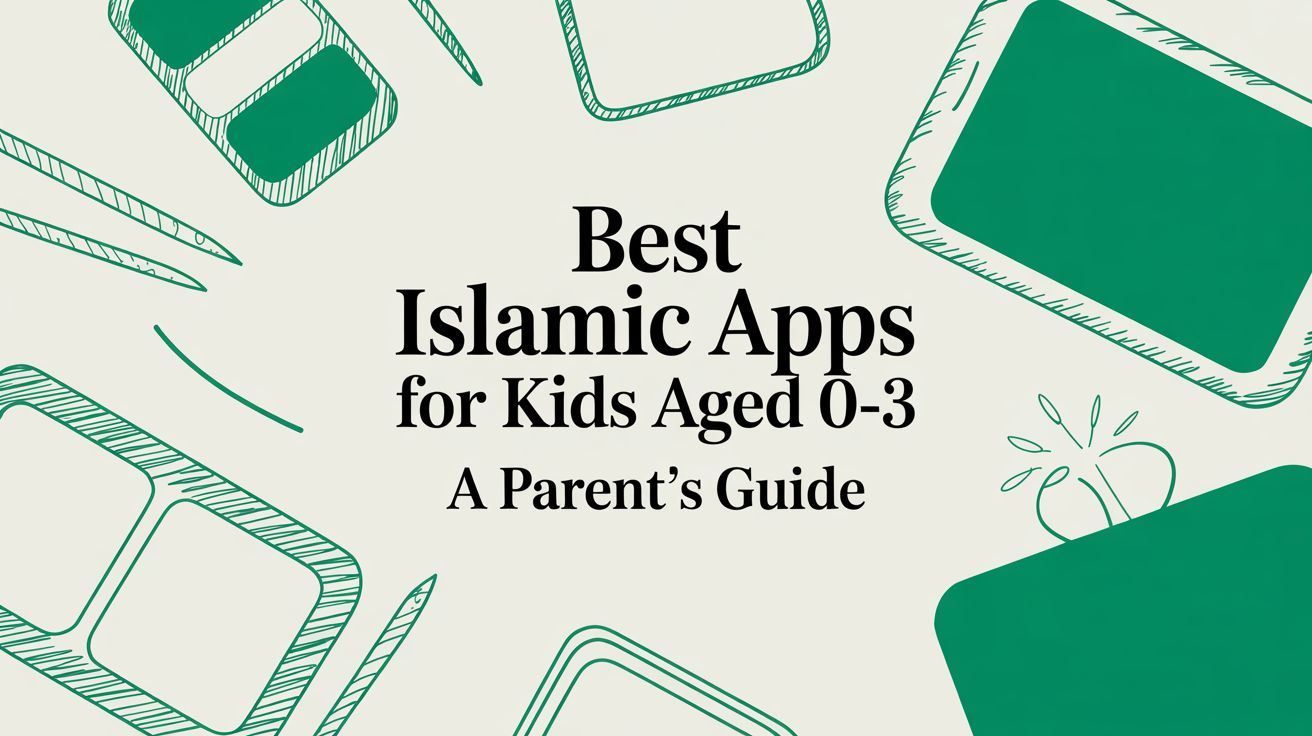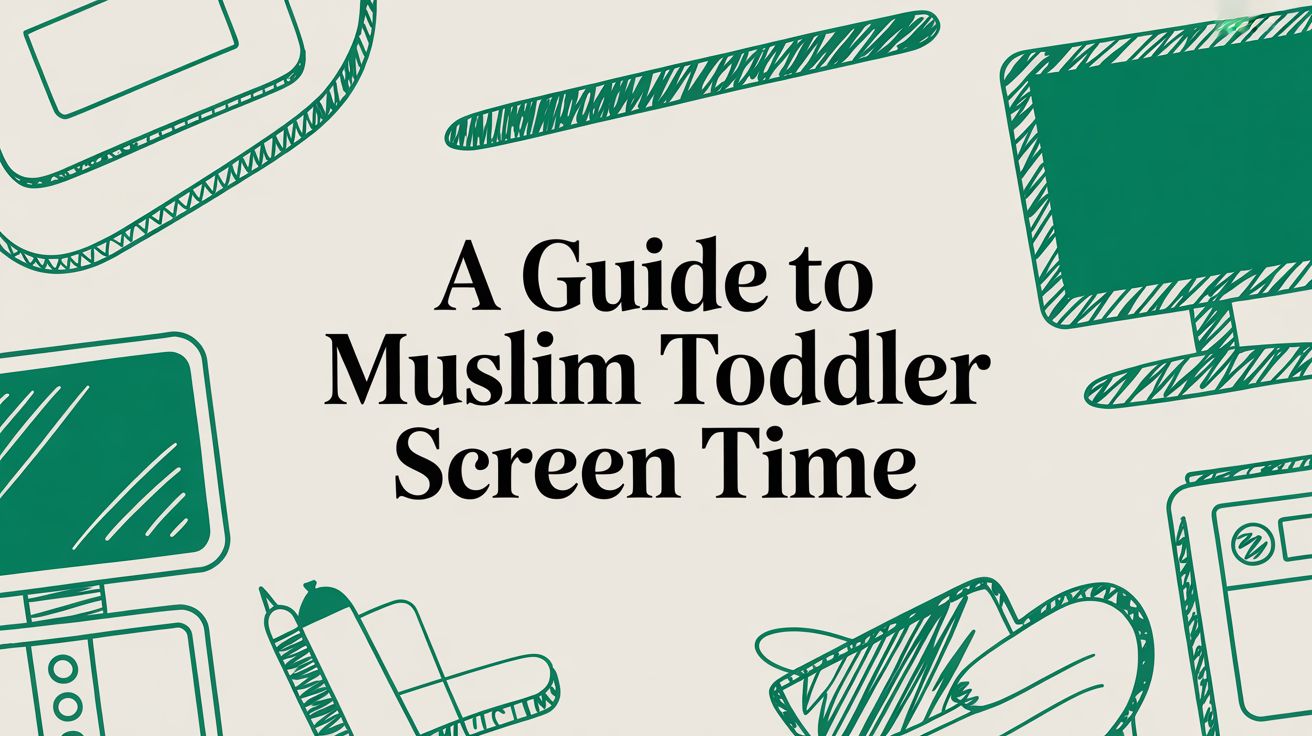For so many Muslim parents, the hunt for the best Islamic apps for kids isn't just about finding entertainment. It's about finding a little pocket of peace. You're looking for a gentle, halal digital space that can safely hold your toddler's attention for a few minutes while you get things done—something calm, ad-free, and beautiful that actually supports your family's values without overwhelming their little minds.
Finding Gentle Screen Time for Your Youngest Muslims
Let's be honest: navigating screen time with a baby or toddler can feel like walking a tightrope. You need to keep them happily occupied—maybe while you're racing to get dinner ready before Maghrib or trying to have a coherent thought during a work call. But the worry is always there. Is what they're watching okay? Is it nurturing? Does it align with our faith? This is a feeling almost every Muslim parent knows well.

The great news is that you're not alone in wanting something better. More and more parents are turning away from big platforms where unpredictable algorithms and jarring ads are the norm. If this sounds familiar, you might find our guide on finding safe Islamic alternatives on YouTube Kids helpful. Our goal here is to help you reframe screen time from a point of stress to a positive, shared activity that feels good for your family.
Why Intentional Screen Time Matters
For children under the age of three, the point of an app isn't really independent learning. Think of it less like a digital babysitter and more like a shared, interactive storybook. It’s about creating brief, beautiful moments together that gently introduce the sounds and sights of Islam.
A well-chosen app can become a wonderful part of your parenting toolkit.
- Creating Calm Moments: Soft, vocal-only nasheeds or simple, slow-moving animations can be a lifesaver for calming a fussy toddler in the car or during quiet time at home.
- Introducing Islamic Concepts Simply: Think high-contrast Arabic letters or sweet animations of Allah's creations, like the sun and the moon. These are the simplest, most engaging first steps into faith.
- Supporting Daily Routines: Playing a short dua before a nap or a meal can help you build those positive, consistent habits right from the start.
Consider this guide your roadmap. We’ll walk you through everything you need to know to confidently choose the best Islamic apps for kids in the 0–3 age group, making sure every moment they spend on a screen is safe, sound, and meaningful.
Your Checklist for Safe and Halal-Aligned Apps
So, how can you really know if an app is right for your baby or toddler? With a sea of options out there, just reading the app store description won't cut it. You need a solid way to check if an app’s content, design, and what’s going on behind the scenes truly line up with your family’s values and your child’s developmental stage.
Think of this checklist as your go-to filter before you download anything new. It's a practical tool to help you spot the good ones and quickly sidestep those that aren't a great fit for your little one.
Content and Values Alignment
First things first: what is the app actually showing your child? For babies and toddlers, this isn't about deep Islamic scholarship. It’s all about the overall feeling—the atmosphere the app creates. You're looking for something gentle, beautiful, and in harmony with the spirit of Islam.
A great app for this age group should feel peaceful and nurturing from the moment you open it.
- Characters and Themes: Do the characters look and act modestly? Are their manners (akhlaq) something you'd want your child to see? Look for themes centered on positive concepts like gratitude (shukr), the wonders of Allah’s creation, or simple kindness.
- Audio and Sound: Is the soundscape calm and soothing? For many families, this is a big one. It means finding apps that use vocal-only nasheeds or sounds, with no musical instruments. The sounds should never be jarring, loud, or chaotic.
- Core Message: Does the app gently reinforce a loving connection to Islam? For a two-year-old, this could be as simple as an animation of a child saying "Bismillah" before eating.
The best Islamic apps for this age range don’t preach; they create a beautiful and peaceful environment. They introduce Islamic concepts through gentle repetition and calm sensory experiences, much like a soft lullaby or a rhyming picture book.
This focus on a serene atmosphere is key. It helps protect your child’s innocence and makes their very first interactions with faith-based content feel positive and safe.
Developmental Appropriateness
An app can tick all the right boxes for Islamic content but still be a bad fit if it isn't designed for a tiny person's brain. Children under three learn best through simple, slow-paced interactions. Overstimulation is a real issue, and a well-designed app will always choose calm over chaos.
Here’s what to look for:
- Pacing and Speed: Animations and screen changes should be slow and predictable. Fast-moving objects, flashing lights, and rapid-fire scene cuts can easily overwhelm a toddler.
- Interaction Simplicity: Can your child interact with just a simple tap? The best apps for this age use basic cause-and-effect. For example, touching the screen makes a star twinkle or plays a soft sound. It should be effortless.
- Minimalist Design: A clean, uncluttered screen with soft colors is always better than a busy one. Too many buttons, characters, and objects on the screen at once will just confuse and frustrate a young child.
Technical Safety and Security
Finally, what’s happening behind the screen is just as important as what's on it. A truly safe app protects your child’s privacy and shields them from the commercial side of the internet. This is a non-negotiable part of finding the best Islamic apps for kids.
Be on the lookout for these critical technical features:
- No Advertisements: An ad-free experience is an absolute must. Ads are distracting at best and can expose your child to completely inappropriate content at worst.
- No In-App Purchases: "Free" apps that are constantly trying to sell you something are a red flag. They create frustrating loops and can nudge children toward materialistic thinking. Often, a single, upfront payment for a quality app is the more honest and safer route.
- Privacy Protection: Does the app collect data? Check for a clear, easy-to-find privacy policy that promises not to track your child or sell your information. Your family’s privacy is paramount.
Quick App Safety Checklist for Parents
Use this at-a-glance checklist to quickly evaluate if an app is safe and suitable for your toddler. It's a simple way to spot the green flags and avoid the red ones.
| Feature | What to Look For (Green Flags) | What to Avoid (Red Flags) |
|---|---|---|
| Content & Values | Gentle themes, modest characters, vocal-only audio, positive Islamic concepts (e.g., Bismillah). | Loud/jarring sounds, instrumental music (if a concern), scary characters, complex or abstract topics. |
| Developmental Fit | Slow pace, simple tap interactions, clean and uncluttered design, soft colors. | Flashing lights, fast-paced action, complicated controls, busy screens with too many elements. |
| Advertisements | 100% Ad-Free. The experience is completely uninterrupted. | Pop-up ads, banner ads, video ads, or any form of third-party advertising. |
| In-App Purchases | A single upfront payment or a clear, honest subscription model with no hidden costs. | Constant prompts to "upgrade," "unlock," or buy coins/items. "Free-to-play" with purchase pressure. |
| Privacy & Data | A clear privacy policy that states no data is collected or sold. No tracking. | Vague or missing privacy policy, requires excessive permissions (access to contacts, location, etc.). |
| External Links & Socials | All external links (to websites, social media) are secured behind a "parent gate." | Easy, one-tap access to a web browser, app store, or social media platforms from within the app. |
Remember, a few minutes of checking these points before you download can save you from exposing your child to something that is distracting, unsafe, or simply not aligned with your values.
Why We're Seeing More Faith-Based Apps for Little Ones
If you've ever typed "Islamic app for toddlers" into a search bar, you're part of a growing movement. Many Muslim parents are on the exact same quest: finding digital tools for our youngest children that are safe, gentle, and in line with our faith.
This isn't a niche concern anymore. Developers are finally starting to listen to this global community of parents who want something more meaningful for their children’s first encounters with technology. They’re realizing that Muslim families are a thoughtful audience, and the old one-size-fits-all approach just doesn't work for the 0–3 age group.
What This Shift Means for Your Family
It’s incredibly validating to know you’re not alone in this. Your desire for safe, halal-aligned content isn't just a personal preference; it's a shared priority for families worldwide. Recognizing this trend helps you see the real effort that goes into a truly good app, making it much easier to spot quality amidst all the noise.
This isn’t just a feeling; it’s backed by real market changes. The children's app market is booming, and a huge part of that energy is coming from parents just like us who are specifically looking for educational content that reflects our faith.
The global apps for kids market hit a value of USD 1.71 billion in 2024 and is expected to climb to USD 2.2 billion by 2025, with this growth set to continue through 2033. A major driver is the rise of smartphone use combined with the strong desire among Muslim families for engaging, faith-aligned content for their kids. You can learn more about the growth of Islamic apps for children.
This isn't just a business trend—it’s a powerful signal that our collective choices are shaping the future of children's media. Every time you seek out and support a high-quality Islamic app, you're casting a vote. You're telling developers to invest more in the safe, nurturing digital environments our children deserve.
How to Make Confident Choices
With more and more apps appearing, knowing how to quickly check for safety is more important than ever. Having a simple mental checklist can help you sift through the options with confidence, so you only download what’s truly right for your family.
This flowchart gives you a quick visual for running through that safety check before you even tap the download button.
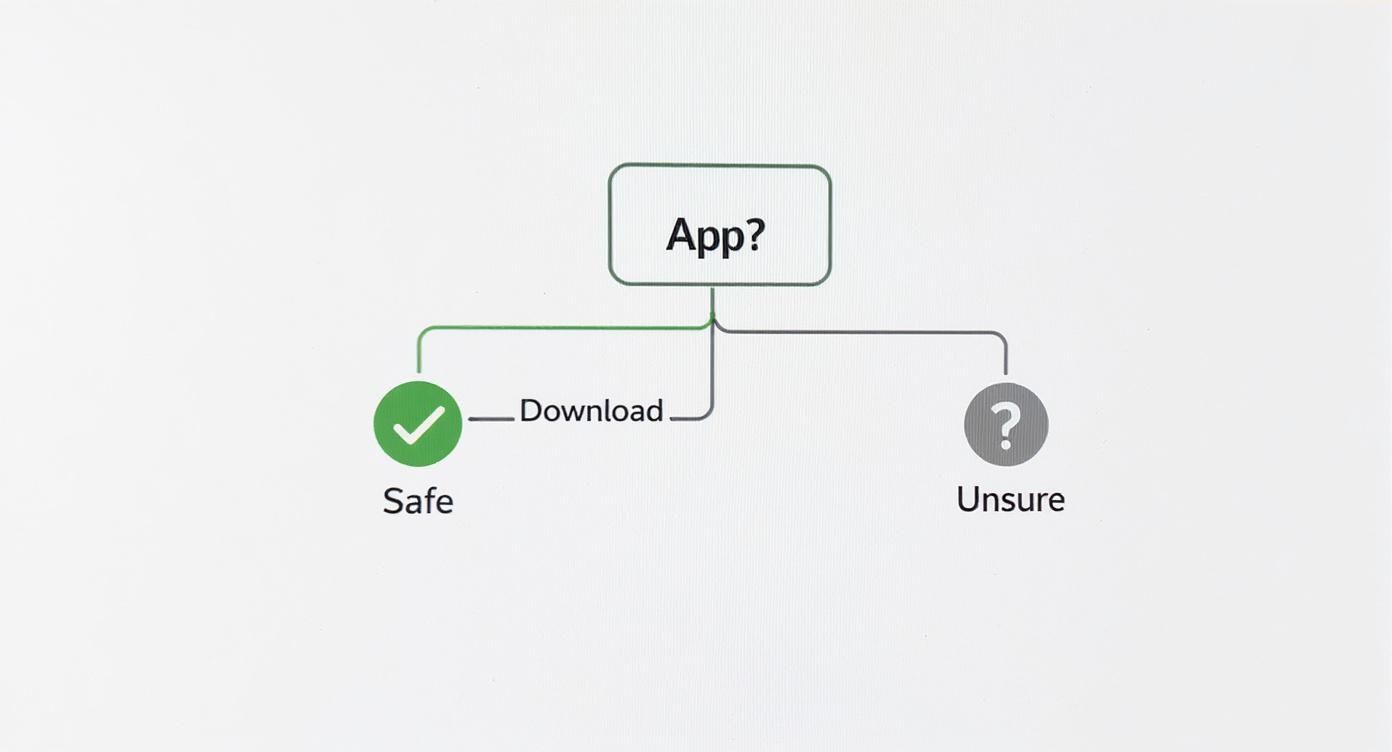
The idea is simple: if an app feels safe and aligns with your family’s values, it’s a contender. If you feel even a little bit unsure, it’s always better to pause and look deeper instead of risking it.
As this market keeps expanding, you can feel more hopeful about finding resources that genuinely fit your family. The growing number of well-designed best Islamic apps for kids means you have more power than ever to choose content that supports your parenting and enriches your child's earliest years with positive, faith-affirming experiences.
What App Content Actually Works for Babies and Toddlers
An app built for a five-year-old learning about the Prophets is worlds away from what your one-year-old needs. When it comes to babies and toddlers, effective digital content isn't about complex stories or quizzes. It's about simple, gentle sensory experiences that are right for their stage of development and fit into a calm, faith-centered home.
The goal here isn't to teach big, abstract concepts. It's to create positive, soothing associations with the sights and sounds of Islam. The very best Islamic apps for kids in this age group get that a baby’s world is built on repetition, contrast, and understanding cause-and-effect.
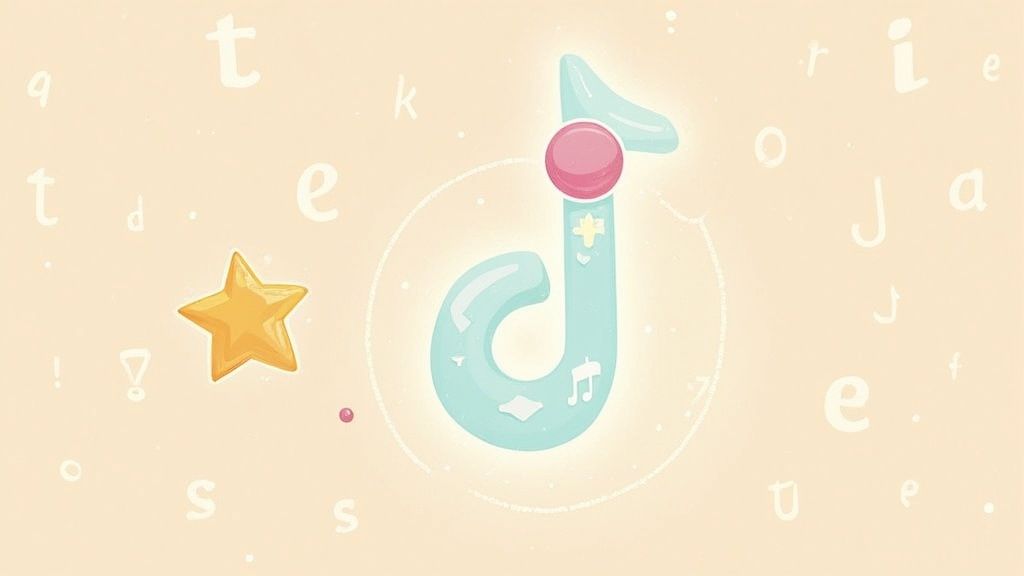
Simple Concepts for Developing Minds
Forget about complicated stories or fast-paced games. The most helpful content for the 0-3 crowd is incredibly simple, designed to capture their attention without overwhelming their developing nervous systems.
Here are the kinds of content that genuinely work for this little audience:
- High-Contrast Animations: Picture a single Arabic letter, like 'Alif' (ا), slowly fading in and out on a clean background. For a baby’s developing eyesight, that sharp contrast and slow, predictable movement are completely mesmerizing.
- Gentle Cause-and-Effect: This is a cornerstone of learning for toddlers. An app that responds to a simple touch—maybe tapping the screen makes a star gently twinkle while a soft "SubhanAllah" is heard—teaches them they can interact with the world.
- Vocal-Only Nasheeds: Melodic, a cappella nasheeds can be wonderfully calming. They’re perfect for soothing a fussy baby during a car ride or creating a peaceful backdrop for quiet playtime at home. There's something deeply reassuring about the gentle rhythm of the human voice.
These simple interactions are more powerful than they seem. They help build foundational neural pathways in a calm and nurturing way, introducing Islamic words and sounds as part of a peaceful, predictable world.
Integrating Apps into Your Daily Muslim Routines
The real magic happens when you weave these apps into your family’s daily life. They aren't meant to be digital babysitters but tools to enrich the routines you’re already establishing. This intentional approach transforms screen time into a shared, meaningful activity.
For example, you could use an app to:
- Settle Down for Bedtime: Playing a simple, animated dua for sleeping can become a lovely new part of your child’s bedtime routine, signaling that it’s time to wind down.
- Make Tummy Time More Engaging: A high-contrast animation of the moon and stars, paired with a soft nasheed, might just keep your baby happily engaged for those few extra, crucial minutes.
- Create Calm During Transitions: A two-minute nasheed app can be the perfect, positive distraction while you’re buckling your toddler into their car seat, turning a potentially stressful moment into a peaceful one.
The key is to use apps as "app-tivities"—short, shared experiences that you control. This isn't about handing over your phone and walking away. It's about sitting together, pointing at the screen, and sharing a beautiful sound or sight for a few moments.
Finding Content That Resonates
As children grow, their tastes in media evolve, and it's useful to see what characters and styles other Muslim families connect with. Shows like Zaky and Friends have become beloved in many households because they model good character in an engaging way. Understanding what makes them popular can offer clues for creating positive media experiences. To explore this further, you can read our thoughts on what makes shows like Zaky and Friends a good choice for families.
Ultimately, the right app content for your baby is whatever helps you create a moment of peace, connection, and gentle exposure to the beauty of your faith.
Common App Pitfalls and How to Avoid Them
Diving into the app store can feel like walking through a minefield. You think you’ve found the perfect app—it’s labeled ‘Islamic,’ the characters are adorable—but within minutes, distracting ads pop up, or your toddler is getting agitated by frantic animations. Spotting these common traps is the first step to protecting your child from a negative experience.
Many apps are cleverly designed to look innocent, but their underlying business models clash with the calm, focused learning environment we want for our kids. Once you know what to look for, you can confidently pick the best Islamic apps for kids that truly serve your family and uphold the safety standards we've discussed.
The Problem with 'Free' Apps
The most common trap is the "free" app that comes with hidden strings attached. These apps usually make money through a constant stream of ads or by pushing in-app purchases, both of which can shatter the safe bubble you're trying to create for your child.
Here’s what to watch out for:
- Aggressive In-App Purchases: You download a free game, and suddenly your toddler can't continue without paying to "unlock" the next level or a new character. This doesn't just cause frustration; it can plant the seeds of materialistic thinking at a very young age.
- Intrusive Advertisements: An ad-supported app can instantly break the safe, halal environment. One accidental tap on a banner ad can whisk your curious toddler away to an external website or the app store, exposing them to content you never approved.
A truly safe app puts your child's well-being first. This often means choosing a premium app with a single, upfront cost. That one-time payment usually guarantees a secure, ad-free space, giving you complete peace of mind.
Overstimulation Disguised as Fun
Another major pitfall is content that's just too much for a toddler's developing brain. Many so-called ‘educational’ apps are a chaotic mix of flashing lights, loud sounds, and hyper-fast scene changes. It might grab their attention for a moment, but it can quickly lead to overstimulation, leaving your child fussy and agitated.
Babies and toddlers thrive on calm, gentle, and predictable interactions. If an app feels frenetic or stressful to you, imagine how overwhelming it is for your little one. It’s always a good idea to test-drive an app yourself to get a feel for its pacing before you hand it over.
Low-Quality and Misleading Content
Unfortunately, just because an app is labeled "Islamic" doesn't mean it's made with care. Some are poorly designed, buggy, or contain content that hasn't been thoughtfully created. You have to look past the label and really assess the quality.
Thankfully, the rise of high-quality, trusted apps has raised the bar for everyone. Take Muslim Pro, for example. By Ramadan 2024, its Quran app had been downloaded over 170 million times and had about 25 million active users. That massive audience has helped establish a benchmark for what parents expect, pushing other developers to create better, more reliable content for children. You can learn more about the growth of enriching digital Islamic experiences for kids.
By keeping an eye out for these potential issues—from hidden costs to overstimulating designs—you'll become much better at spotting the good ones. This empowers you to choose apps that are not just fun but are genuinely safe, calming, and beneficial for your child's development and spiritual growth.
Making Apps a Healthy Part of Your Family Routine
Finding a great app is only the first step. The real magic happens when you weave it into your family’s rhythm thoughtfully and with purpose. Don't think of it as a digital babysitter. Instead, picture it as an interactive storybook—a tool for creating short, beautiful moments that strengthen your bond and gently introduce your little one to their faith.
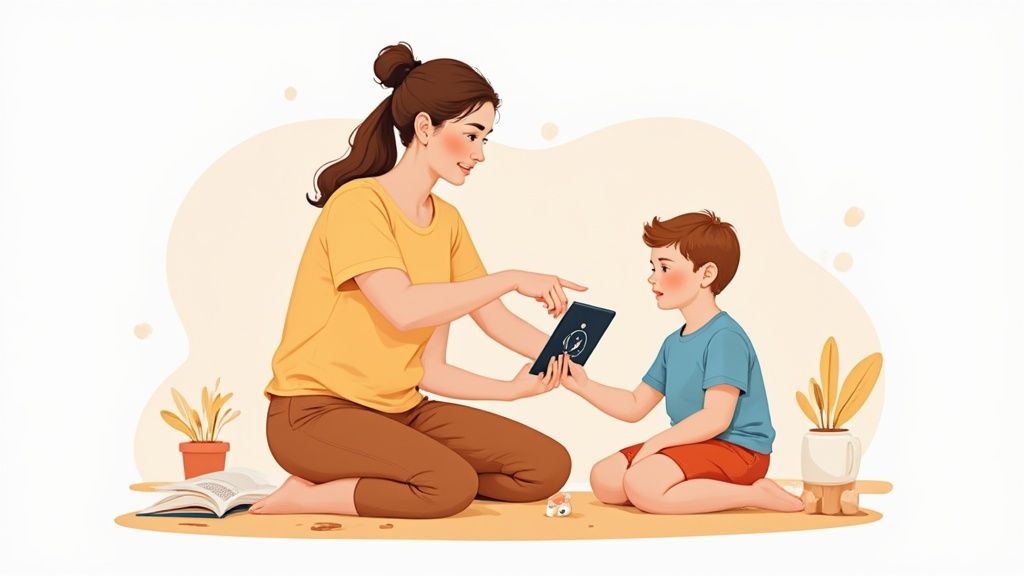
The idea is to shift from passive watching to active sharing. When you explore an app with your toddler, it becomes a warm point of connection.
Turning Screen Time into "App-tivities"
An "app-tivity" is just a short, focused activity you do together using an app. It’s about being present, even for a few minutes, to guide the experience. This simple shift transforms what could be an isolating activity into a shared moment of warmth and learning.
Here are a few easy ideas to get you going:
- Sing Along Together: When a gentle, vocal-only nasheed starts playing, sing along with your child. Hearing your voice is comforting, and it encourages them to babble and make their own first sounds.
- Trace with Your Finger: If the app shows an Arabic letter, trace it on the screen with your finger and guide your toddler’s hand to do the same. This adds a wonderful, hands-on element to their learning.
- Point and Name: Use simple animations of Allah's creations—like the sun, moon, or animals—as an opportunity to point and say the words together. You’ll be building their vocabulary within a beautiful, faith-centered context.
The healthiest way to use apps is to see them as just one of many tools in your parenting toolkit. They should always complement, never replace, the hands-on, real-world play that is absolutely essential for your toddler's development.
Setting Gentle and Consistent Boundaries
A healthy relationship with technology also means knowing when to put the device away. Setting gentle boundaries helps your child understand that app time is a special, limited part of their day, not something that's always available.
This becomes especially important when you’re trying to build a predictable daily rhythm. Toddlers thrive on structure, and consistent limits help maintain that sense of calm. If you're looking for more ideas on this, our guide to creating a peaceful Muslim toddler routine has some really practical tips.
Here are a few simple, low-stress ways to manage app time:
- Use It for Transitions: Keep app sessions short and sweet. They can be a lifesaver for those tricky five-minute waits, like at the doctor’s office or while you're getting them buckled into the car seat.
- Prioritize Offline Learning: For every few minutes of app time, make sure there are hours of unstructured, hands-on play. Think stacking blocks, scribbling with crayons, or exploring the garden.
- Create a Clear "All Done": When it’s time to stop, give a calm one-minute warning. Then, say "All done!" with a cheerful voice before putting the device away for later.
In the end, the best Islamic apps for kids are the ones that bring you closer. By using them with care and intention, you can create joyful, shared experiences that plant the first beautiful seeds of faith in your child’s heart.
Frequently Asked Questions
Stepping into the world of faith-based apps with your little one can bring up a lot of questions. That’s completely normal—we’re all navigating this new territory together. Here are some straightforward answers to the things Muslim parents ask most, designed to help you feel confident in your choices.
When Can I Introduce Islamic Apps to My Baby?
Most child development experts recommend holding off on screen time for children under two. When you feel the time is right, try to reframe it from "screen time" to a brief, shared "together time."
You might start exploring simple, slow-paced apps for just a few minutes a day with your child starting around 18 months old. The key here is interaction with you, not with the screen. Think of it like a digital board book you're looking at together—you point, you talk, you laugh. Real-world, hands-on play should always come first.
Are There Any Truly Free and Safe Islamic Apps for Toddlers?
It's tough to find high-quality apps that are genuinely free without ads or in-app purchases. The reality is that building and maintaining a safe, high-quality app requires a lot of work and resources from the developers.
Some apps offer a safe but limited free version, which is a fantastic way to see if it's a good fit for your family. Often, the best route is a small, one-time payment for a premium app from a developer you trust. This usually guarantees a secure, ad-free space, giving you priceless peace of mind that your child won't stumble upon something inappropriate.
How Do I Know if an App Is Genuinely Islamic?
For the 0–3 age group, the content you'll find is incredibly simple. We're talking about things like Arabic letters, foundational words like "Bismillah," or sweet animations celebrating Allah's creation. At this stage, the risk of running into complex or incorrect theology is very, very low.
The real question to ask is whether the app’s vibe aligns with core Islamic values: gentleness, beauty, and kindness. Look for developers who are transparent about their mission and check reviews from other Muslim parents. Their firsthand experiences are often the most telling.
What Kind of App Is Best for a Toddler Sensitive to Stimulation?
If your child gets overwhelmed easily, less is definitely more. The best Islamic apps for sensitive little ones will feel noticeably calm and gentle from the moment you open them.
Here’s what to look for:
* Minimalist Design: Clean screens with plenty of open space.
* Soft Color Palette: Think muted, soothing tones instead of bright, jarring colors.
* Gentle Audio: Calm vocal-only sounds or soft nature noises.
* Slow Animations: Nothing with flashy effects, quick cuts, or startling sounds.
The aim is a peaceful, engaging experience, not a hyperactive one. It’s always a good idea to play with the app yourself first to get a feel for it before you introduce it to your child.
Finding a truly safe, ad-free, and spiritually uplifting digital corner for our youngest children is a big deal. At Babymode, we're building the very solution we wished we had for our own kids.
Join the Babymode waitlist for early access and special launch pricing!
